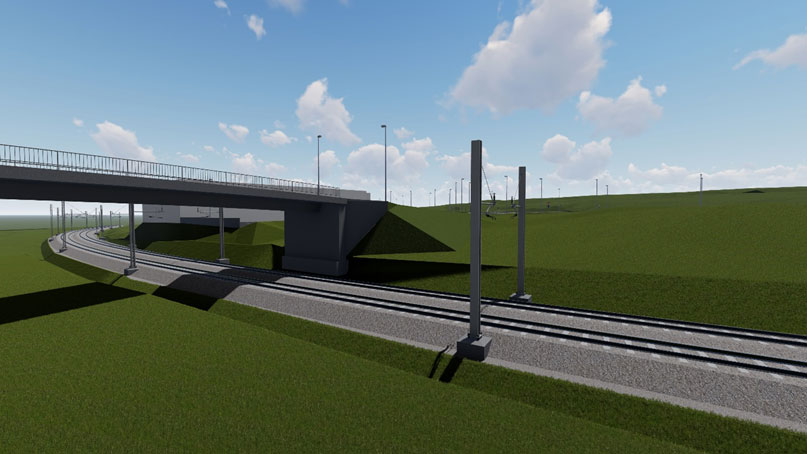Track gauge is the minimum distance between the inner edges of the rail heads and is measured at a distance of 0 to 14 mm below the upper edge of the rail. At the beginning of railway development, there were no universally valid technical specifications, so engineers determined this value on their own. As a result, track gauges vary around the world and are often an obstacle to the wider operation of railway networks. In general, the types of railway track gauges are divided into standard gauge, narrow gauge, and broad gauge.

Figure: Cross-section of a railway with a standard track gauge in FERROVIA software.
The standard gauge railway tracks
The world’s first railway was built in England and had a track gauge of 1435 mm (4 feet 8 1/2 inches). This gauge was then adopted by the vast majority of railways in Europe and elsewhere in the world so that railway lines with this track width are now called standard gauge railway tracks. Most railways in Europe, the United States, Canada, China, and Argentina have this track gauge.

Figure: Track gauge around the world | Source: https://commons.wikimedia.org/wiki/File:Rail_gauge_world.png
There is no clear answer to the question of why the value of 1435 mm was chosen. Some believe that the track gauge was chosen based on the distance between the wheels of ancient Roman chariots, while others claim that the choice of track gauge value was probably a coincidence.
The broad-gauge railway tracks
Broad-gauge railway lines are those that have a track gauge wider than the standard track gauge. Such railway lines are built in Russia (1524 mm), Estonia, Latvia, Lithuania, Ukraine, Spain, Portugal, Finland (1524 mm), Ireland (1600 mm) and India (1676 mm).
In Russia, the wider gauge was chosen to increase the carrying capacity and driving stability. At the same time, of course, the price of the investment increased. Although it was later possible to adapt to Europe, the decision was made to use their own gauge, as it was feared that Russia would be attacked, if trains from other countries entered unhindered.
The narrow-gauge railway tracks
On the narrow-gauge lines, the gauge is less than the standard width. Such railways are the least represented. They are found in South Africa, where the track gauge is 1067 mm. This track gauge is also called Cape gauge, after the former Cape Province of South Africa, which introduced this gauge in 1873. The second-largest country with a narrow track gauge is Argentina. Its gauge is called a Meter gauge because the width value is 1000 mm. Railways with a track gauge of less than one metre are very rarely used because they have a lower carrying capacity.
Track gauges in Ferrovia
The Ferrovia software currently supports ten different track gauges. If the desired track gauge is not listed below, we can add it.


Figure: 3D model of a double-track railway designed with FERROVIA by CGS Labs
If you are interested in CGS Labs Software Solutions and would like to get further information or download a free trial.
